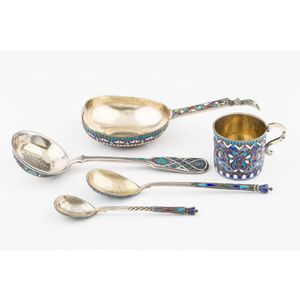Russian Silver & Enamel Collection
You must be a subscriber, and be logged in to view price and dealer details.
Subscribe Now to view actual auction price for this item
When you subscribe, you have the option of setting the currency in which to display prices to $Au, $US, $NZ or Stg.
- Assay / Assayed - Assaying is the testing of a metal, most commonly silver and gold to determine its ingredients and quality. In Britain, once an item of silver or gold has been assayed, a mark is stamped on it, certifying its purity. Known as hallmark, it derives its name from the Guild Hall of the Goldsmiths' Company, who recieved its Charter in 1327 giving it the power to assay and mark articles of gold and silver.
- Circa - A Latin term meaning 'about', often used in the antique trade to give an approximate date for the piece, usually considered to be five years on either side of the circa year. Thus, circa 1900 means the piece was made about 1900, probably between 1895 and 1905. The expression is sometimes abbreviated to c.1900.
- Foliate - Decorated with leaves or leaf-like forms.
This item has been included into following indexes:
- Russian
Visually similar items

Set of 6 antique sterling silver tea spoons Sheffield 1911

Pair Georgian fiddle & thread tea spoons. In sterling silver marked London, 1811, RCGS approx 58g, 13 cm long

George IV sterling silver basting spoon Old English pattern with engraved initial, London, 1822, maker, William Seaman with other Georgian Old English sterling silver basting spoon

Three William IV silver teaspoons, fiddle pattern, Richard Britton, London 1835. (3)
